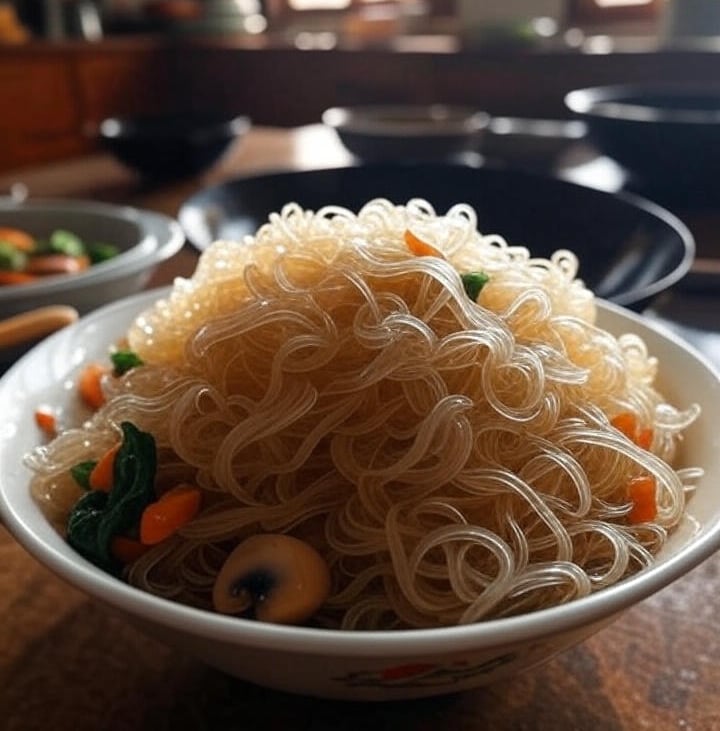Welcome to Noodles of Asia ! - A Woke Noodle Blog
Unraveling Glass Noodles: A Journey Through Asia’s Translucent Treasure


Hey there, noodle enthusiasts! If you've ever savored a dish of translucent, slippery noodles in a savory stir-fry or delicate soup, you’ve likely tasted glass noodles. These unique strands, typically made from mung bean starch or sweet potato starch, are a beloved staple in Asian cuisine, valued for their chewy texture and versatility. Whether enjoyed hot in a hearty broth or cold in a refreshing salad, glass noodles bring a distinctive charm. In this post, we’ll explore their origins, history, some fascinating facts, and a few famous recipes to inspire your next culinary adventure. Let’s dive in!
Origins and History of Glass Noodles
Glass noodles are believed to have originated in China over 1,000 years ago, with early records of starch-based noodles emerging during the Tang Dynasty (618–907 CE). Made from mung bean starch, they spread across East and Southeast Asia via trade routes, reaching Korea, Vietnam, and Thailand by the medieval period. In China, they became a staple in dishes like cellophane noodle stir-fries, while in Korea, they evolved into japchae. During the 20th century, migration introduced glass noodles to global cuisines, where they’ve gained popularity in fusion dishes from the U.S. to Europe.
Interesting Facts About Glass Noodles
Glass noodles aren’t just food—they’re a cultural delight! Here are some intriguing tidbits:
Regional Variations Galore: From Korea’s japchae with stir-fried veggies and beef to Vietnam’s bun rieu with crab broth, and Thailand’s yam wun sen with spicy salad, each region offers unique preparations.
Noodle-Making Craft: Traditionally, glass noodles are made by extracting starch from mung beans or sweet potatoes, forming it into strands, and drying them, giving their signature transparency when cooked.
Dietary Appeal: Naturally gluten-free and low in calories, glass noodles are a favorite for health-conscious eaters and those with gluten sensitivities.
Global Fusion: In Western kitchens, they appear in creative dishes like glass noodle stir-fries with Italian herbs or cold salads with global dressings.
Cultural Significance: In some Asian cultures, glass noodles symbolize longevity due to their slippery, endless nature, often served at celebrations.
These facts highlight glass noodles’ journey from an ancient craft to a global culinary star.
Famous Glass Noodle Recipes
Glass noodles’ charm lies in their versatility. Here are some iconic recipes, from comforting classics to creative twists. (Note: These are overviews—adjust to taste and check full recipes online for details.)
Japchae: Korean stir-fried glass noodles with soy sauce, sesame oil, beef, and assorted vegetables—a festive favorite.
Yam Wun Sen: Thai spicy glass noodle salad with shrimp, pork, peanuts, and chili-lime dressing—refreshing and bold.
Ants Climbing a Tree: Chinese spicy pork and glass noodle stir-fry, named for the meat clinging to the noodles—simple yet flavorful.
Bun Rieu: Vietnamese crab and tomato broth with glass noodles, topped with herbs and tofu—a hearty soup.
Chap Chae: Korean variation of japchae, often lighter with more veggies and less meat, perfect for a quick meal.
Glass Noodle Soup: Chinese clear broth with glass noodles, mushrooms, and green onions—a light, soothing dish.
For a hands-on challenge, try making glass noodles at home: Mix mung bean starch with water, form into strands, and dry—or use pre-made versions for convenience.
Wrapping It Up
Glass noodles are more than just food—they’re a connection from ancient Asian traditions to modern global kitchens, with endless variations to explore. Whether you’re craving a hot bowl on a cool evening or a fresh dish in warm weather, glass noodles deliver. Next time you’re at an Asian restaurant or in your kitchen, give one of these recipes a try. What’s your favorite glass noodle dish? Share in the comments—I’d love to hear! Until next time, happy slurping! 🍜
